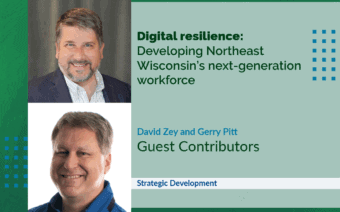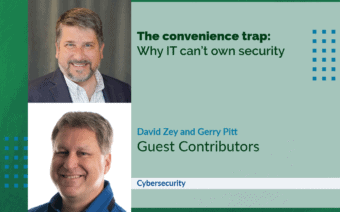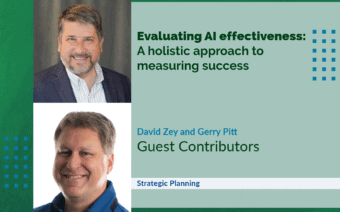
October 19, 2023
As mentioned in my previous column, the journey to build a technology-enabled organization that balances stability and agility, while confronting risks and embracing innovation, all while avoiding the burdensome weight of tech debt, can be extremely challenging.
The IT Management and Growth Pyramid can be used as a guide for manageable and effective technology planning.
In this column, I’ll zero in on the pyramid’s groundwork layers: Foundation and Infrastructure – crucial pieces for achieving a bimodal IT strategy and operational stability.

Foundation:
The Foundation layer is your strategic roadmap.
It’s about understanding your business’s technology needs and aligning them with your broader goals.
This involves a three-step process in planning your journey:
Know where you are: Start by assessing your current resources. Analyze your strengths, weaknesses, opportunities and threats (SWOT) and evaluate the technical competency of your team. Identify what’s working and what needs improvement.Know where you’re headed: Outline your business goals – both external and internal. Be clear about the role technology will play in achieving these goals. Remember, technology should be an integrated part of your strategy, not an afterthought.Know when you get there: Establish metrics for success. Whether it’s days without communication interruptions, speed of decision-making data retrieval or average time to resolve business issues, have a baseline to measure against.
Infrastructure:
Building on the Foundation, the Infrastructure layer is where the rubber meets the road.
This is about the tactical aspects – people, vendors, partners, hardware, software, networks and cybersecurity measures – that make your strategy actionable.
Supplies for the journey: What do you need upfront, and what can be acquired along the way? This insight helps you gauge your limitations and the speed at which you can advance toward your business objectives.Set waypoints: Pinpoint key milestones as a way to evaluate your progress, tying back to the “know when you get there” step. These waypoints serve as tangible markers to assess how well you’re advancing on your strategic roadmap.Needed travel companions: The most significant resource in this layer is the network of technically skilled individuals around you. Their expertise enriches your journey and can be a game-changer in achieving your goals.
The value of practical technology planning in business operations cannot be overstated.
A proactive approach gives you more options and flexibility in accomplishing daily operations.
To illustrate this, here are two real-to-life stories that delve into the key decisions made in the Foundation and Infrastructure layers of technology planning.
A success story in accounting
Meet Sarah, the optimistic owner of a budding accounting firm.
For her, technology is a necessary evil essential, but not her forte.
With no internal IT team and just a handful of employees, her needs are straightforward: uninterrupted workflow, secure data storage and seamless communication.
Sarah’s primary goal with the Foundation layer is to keep her business running smoothly without technology becoming a hindrance.
She decides only to own technology that is core to her business – networking, internet, laptops and third-party software.
But when it comes to phone systems and file storage servers, she opts for cloud solutions.
She also implements a basic backup strategy, focusing on data and configurations. Understanding the risks involved, she invests in only third-party cyber insurance to cover customer liability but is willing to risk business interruption for the time being.
In terms of Infrastructure, Sarah chooses a reputable business cloud provider for her file storage and email needs.
For emergency tech support, she contracts a locally managed IT vendor who not only knows her setup but can also act as a consultant for software and hardware purchases.
Lastly, she seeks mentorship from another entrepreneur who is tech-savvy.
This mentor advises her on best practices and helps her navigate the complexities of technology in business.
In this way, Sarah successfully lays a strong Foundation and builds a robust Infrastructure, ensuring that technology serves as an enabler, not an obstacle, in her business growth.
A practical approach to manufacturing
John, the chief financial officer of a multi-plant industrial manufacturer in rural Wisconsin, is a man of practicality.
He lives by the motto: “If it’s not broken, don’t fix it,” and views organizational change as a potential risk.
With responsibilities spanning finances and IT, John sees technology as a cost center that must also support data-driven decision-making.
John’s technology objectives at the Foundation later are clear-cut: ensure smooth operations, leverage data for strategic decisions and maintain cost efficiency.
He decides to own only technology that is absolutely core to the business – which includes networking, phone systems and laptops.
He’s hesitant about owning and maintaining all plant equipment and software, preferring to rely on third-party solutions for the ERP/MRP (enterprise resource planning/material requirements planning) system and file storage while maintaining on-premise applications that support the collection of data from manufacturing equipment.
Understanding the catastrophic impact of a plant shutdown, John institutes a basic backup strategy with proof of recoverability.
He opts for cloud storage solutions and ensures data and configurations are regularly backed up.
To mitigate risks further, he invests in both first- and third-party cyber insurance.
For John, the backbone of the operation lies in reliable networking and telecommunication equipment between plants.
In terms of Infrastructure, he allocates a significant portion of the budget to ensure these are top-notch.
He then moves essential business applications like the ERP/MRP system, email and file storage to the cloud – centralizing data reporting in the process.
Team development is another priority.
John invests in training Mike, his senior developer, to take on the roles of Level 1 support, thought leader and vendor manager.
For Level 2 support, monitoring and security, he contracts a nearby managed IT vendor familiar with its setup and capable of interfacing with other vendors.
Additionally, he seeks an external technical vendor to guide process improvement initiatives aimed at boosting operational efficiency and system stability.
To round off his strategy, John implements semi-annual exercises for data and system recovery.
This involves testing the recoverability of data backups and the reinstallation and reconfiguration of other owned equipment.
By adopting this grounded, risk-averse approach, John ensures technology serves as a steadfast pillar, supporting the company’s growth and operational efficiency.
Establishing stability
Sarah and John serve as practical case studies for effectively implementing the Foundation and Infrastructure layers of the IT Management and Growth Pyramid.
Their strategies not only ensure operational stability but also lay the groundwork for the agility and innovation that come into play in the pyramid’s – Innovation and Risk Management layers – which we’ll delve into in a future column.
 CWAIC helps Central Wisconsin embrace the full power of AI
CWAIC helps Central Wisconsin embrace the full power of AI ‘We’re past due as an industry to grow up some’
‘We’re past due as an industry to grow up some’








